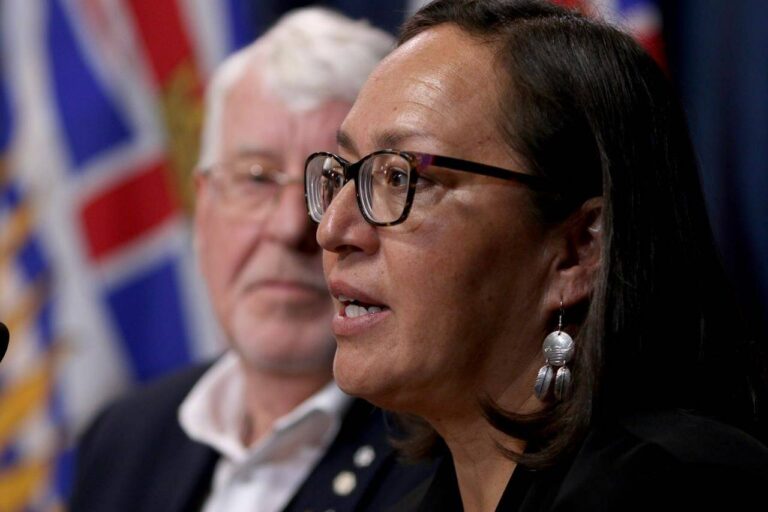First Nations Health Authority acting chief medical officer Dr. Nel Wieman was consulted on the BC Coroner Service’s recent death review panel report on the toxic drug crisis that was released Nov. 1, 2023. Wieman speaks about the illicit drug toxicity deaths in the province and about the effect on First Nation’s communities during a press conference at B.C. Legislature in Victoria, B.C., on Monday, February 24, 2020. THE CANADIAN PRESS/Chad Hipolito
First Nations Health Authority rep says safer supply engagement lacking in First Nations communities
A recent BC Coroners Service death panel review on the ongoing toxic drug crisis and safer supply is also calling for Indigenous-specific solutions.
The coroners service released its latest report Wednesday (Nov. 1). It included recommendations including increased access to safer supply for people without a prescription, developing an application for agencies to distribute regulated substances on a non-prescription basis, and for the Mental Health and Addictions Ministry to engage with people with lived and living experience of substance use.
READ MORE: B.C. rejects experts call for non-prescription access to safer drug supply
The final recommendation was for the province to identify Indigenous solutions to the crisis, and as the only First Nations Health Authority representative on the panel, Dr. Nel Wieman said it was her major contribution.
But when asked what those solutions – or steps toward a solution – could be, Wieman said engagement from First Nations people hasn’t been fully collected.
“I can’t tell you what those steps would be because there has been very little in the way of Indigenous and First Nations engagement on this issue,” she told Black Press Media Friday.
Despite lack of engagement, First Nations people are over-represented in B.C.’s drug-poisoning crisis. Indigenous people made up 16.4 per cent of the 2,314 toxic drug deaths in B.C. last year, despite only representing 3.3 per cent of the province’s total population.
First Nations people died from toxic drugs at 5.9 times the rate of other B.C. residents last year, a more than five-times increase from 2021.
The day after the report was released, the First Nations Health Authority said the one-size-fits-all approach doesn’t work in either harm reduction or First Nations communities. The statement added that any model implemented “must be informed by, and responsive to, the unique needs and circumstances of different communities and populations.”
Wieman said the FNHA’s role is to provide the most accurate, comprehensive information about an issue so each B.C. First Nation can make its own decision about what is best for community members. B.C. is also home to dozens of individual Nations, Métis and Inuit people, and she can only speak for the work FNHA is doing.
“We respect communities’ ability to be self-determining and we recognize B.C. First Nations rights to their health and well-being.”
It’s only then FNHA will have a better idea of what safer supply could look like in different sub-regions of the province, she said.
READ MORE: First Nations ‘particularly and disproportionately’ overrepresented among B.C. toxic drug deaths
In April, the health authority shared Indigenous-specific data around the toxic drug deaths in 2022.
First Nations groups first released data on toxic drug deaths in 2017, noting then that Indigenous people are three times more likely to die of a drug overdose. They were also five times more likely to experience an overdose.
That rate has nearly doubled.
Wieman said she wanted that data to be released differently than in years past.
“What we did this time was we weave that data into stories, so we had a young First Nations man who has recovered from opioid-use disorder and are still in healthy active recovery. We had a father who lost a daughter to the toxic drug crisis.”
B.C. marked seven years in April since the drug crisis emergency was first declared. A crisis that was made worse with a “terrible collision” with the pandemic.





